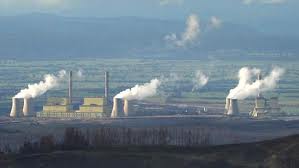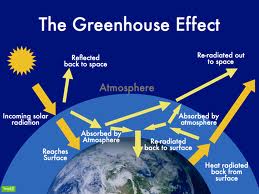Green House Gases
Introduction
As the name suggests, the term had its origin from the practice in cold countries of encasing vegetation in glass chambers to protect them from frost. It was observed that there was a continued rise in temperature in such chambers even when the outside temperature remained low. The transparent glass roof and walls of green house allow the sun’s rays to pass through and strike the ground. The reflected radiation is of longer wavelength than the incident radiation. A significant portion of the former is observed by the glass. As long wavelength radiation generate heat, this results in rise in temperature inside the house. Similarly, on earth the sun’s rays strike the surface of earth and the long wavelength radiation emitted by earth are observed by atmospheric gases, there by contributing to the rise in temperature. The atmospheric gases acts like the glass of green house which is transparent to the sunlight coming in but they strongly absorb the infra red radiation, which the earth sends back as heat. A part of the heat so trapped in these atmospheric gases is reemitted to the earth’s surface. The net result is the heating of earth’s surface atmosphere by this phenomena called the “Green House Effect“ causing global warming.


Green Houses Gases
The term “Green House Gases” is used for radiatively active gases that are transparent to incoming short wave radiation from the sun, but absorbs out going long wave radiation and reemits this energy in all direction. These gases include carbon dioxide, methane, chlorofloro carbon, ozone, nitrous oxide, water vapours and other. The CO2 is the main culprit and contributes to about 50% of the global warming.
| Green House Gases(GHG) and their percentage contribution to global warming |
| Gases |
%age Contribution |
| CO2 |
9 – 26%* |
| CH4 |
4 – 9%* |
| CFC |
4-8%* |
| O3 |
3 – 7%* |
| N2O |
4-8%** |
| Water Vapours |
36 – 72%* |
*IPCC (2007), Fourth Assessment Report
**Inventory of U.S. Greenhouse Gas Emissions and Sinks: 1990-2011 (April 2013)
Since the concentrations of GHG have been continuously increasing because of deforestation, industrialization, increased burning of fossil fuels, mining, exhausts from increasing number of automobiles and other anthropogenic activities, There is an increasing concern about the possible “global warming”. Scientists fear that if proper precautions are not taken, the concentrations Of GHG in the atmosphere may double within the next 50-100 years. If this happens, the average global temp may increase by 4 to 5oC.
i. Carbon dioxide:
The CO2 concentration is rising significantly, each year because of excessive use of fossil fuel and intense deforestation. The concentration of CO2 has increased from 283 ppm in 1880 (pre Industrial Revolution period) to 356 ppm at present. The CO2 has shown an increase of 25% due to human activities and expected to double CO2 level by year 2075.
ii. Methane:
(Present average global conc. 1.7 ppm V) Methane is increasing at a rate of about 1% per year due to more extensive use of paddy fields in cultivating rice, increasing number of domestic ruminants, biomass burning and due to leakage of natural gas. About 20-50 % increase during next 50 years seems to be possible.
iii. Chlorofloro Carbons:
Well known depletors of stratospheric O3. Used as coolants in refrigerators, propellants in aerosol sprays, plastic foam materials like “thermocols” or Styrofoam. The common species are CFC –11 and CFC-12. CFC is increasing at a rate of 5% per year. CFC have as much as 20,000 times more impact on climate per additional molecule than CO2.
iv. Nitrous Oxide:
(Present avg. conc. 0.30 ppm V ) N2O is increasing by about 0.3% per year. The industrial concentration may have been 5-10% below the values observed today. The increase is probably due to the use of N fertilizer in agriculture and forestry and also the combustion processes and is expected to reach 0.35-0.40 ppm V in the next 50 years.
v. Ozone:
It has been recognized that O3 is important in the earth radiation budget. Ozone in North hemisphere troposphere has probably on average increased by more than 10% because of human activity. Concentrations and increase % of radiatively active (green house) gases.
Source: IPCC (2007) Fourth Assessment Report
| Concentrations and increase % of radiatively active (green house) gases |
| GHG |
Conc.(ppm) |
Increase % per year |
| CO2 |
356 |
0.4 |
| CH4 |
1.7 |
1.0 |
| N2O |
0.3 |
0.3 |
| CFC |
0.0005 |
5.0 |
Impact of Global Warming
The “Global Warming” by the “green house effect" cannot be under estimated. There is increasing evidence of global warming. Unusual climatic variations and extreme weather condition are being experienced worldwide. Global warming is likely to have a major impact on availability of drinking water, coastal communities, public health and agriculture production.
a. Impact on Agriculture
Slight increase in surface temperature, say 1oC can adversely effect the world food production. Particularly in tropical countries of Africa, South America and Asia where the productivity is already poor. The wheat growing zones in the north latitude will be shifted from the USSR and Canada to the poles i.e. from fertile to poor soil (in the north pole). Poorer soil can reduce productivity. Yet evidence also exists that increased CO2 accelerates growth of trees. Agriculture scientists generally take a favourable view of the increase in CO2. Not only will more CO2 make crops grow faster and larger but they will also become resistant because higher CO2 concentrations also improve the efficiency with which plants use water.
b. Impact on Forest
On one hand, increased concentration of CO2 has a beneficial fertilization effect on plants, and also enables plants to use water more efficiently on the other hand forest fires are likely to become more frequent and severe if soils become drier. Changes in pest populations could further increase the stress on forests. If the climate becomes wetter, then forest are likely to expand toward rangelands and other areas that are dry today; if climate become drier, then forest will retreat away from those areas. The projected 2oC (3.6oF) warming could shift the ideal range for many North American forest, species by about 300 km (200 mi) to the north. If the earth warms 2oC (3.6oF) in 100 years, however, the species would have to migrate about 2 miles every year.
c. Impact on the Primary Productivity of Ocean
The biological productivity of the ocean would also decrease due to warming of the surface layer, which in turn reduces the transport of nutrient from deeper layers to the surface by vertical circulation.
d. Rise in Sea Level
Another effect is the rise in sea levels. Since oceans act as reservoirs of heat, it could result in rise of sea levels by as much as 1 mt. due to expansion of sea water at increased temperatures, partial melting of glaciers, ice caps of greenland and also polar ice caps. This rise of sea levels would threaten coastal countries some 60 odd islands may be totally submerged. In India coastal cities such as Madras, Goa, may meet similar fates. Scientist assume that 1% of Egypt, 6% of Netherlands, 17.5% of Bangladesh and 80% of Majura Atoll could be under water if sea level rises by 1 mt.